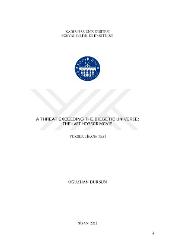| dc.contributor.advisor | Tüzün, Defne | en_US |
| dc.contributor.author | Dursun, Oguzhan | |
| dc.date.accessioned | 2019-07-12T08:36:44Z | en_US |
| dc.date.available | 2019-07-12T08:36:44Z | en_US |
| dc.date.issued | 2017 | en_US |
| dc.identifier.uri | https://hdl.handle.net/20.500.12469/2077 | |
| dc.description.abstract | This thesis focuses on the film - The Last Horror Movie (Julian Richards 2003) - in which the protagonist is a serial killer who is recording his murders and trying to shoot his own movie. Additional to using a variety of conventions of the horror genre the film includes “found footage” mode. What makes the film distinct from its counterparts and renders it worthy of deeper inquiry is that found footage form takes on a different function. The thesis firstly makes a detailed formal analysis of The Last Horror Movie and evaluates the movie with respect to horror genre and found footage mode. The thesis analyzes how the movie uses the patterns of horror genre and found footage strategies and with which aspects does the movie diverge from these conventions. The thesis investigates how and why the movie undermines horror codes and conventions by focusing on the narrative and narration aspects of the film and by instrumentalizing the found footage mode. in the film the facts that the protagonist avoids demonstrating killings scenes rejects to use darkness as an element of horror interrupts all the horror scenes and gives exhaustive explanations to the audience are elaborated in great detail. The film does all these depending on the reality claim of the found footage mode. By demolishing the ordinary conventions of horror genre with these strategies the film claims that it creates a horror effect which is more realistic and convincing. | en_US |
| dc.description.abstract | Bu tez, işlediği cinayetlerin video kaydını alıp bu kayıtlarla kendi filmini çekmeye çalışan seri katil Max'in başkarakter olduğu The Last Horror Movie (Julian Richards, 2003) filmine odaklanıyor. Film, korku türüne ait başlıca konvansiyonlarını kullanmakla beraber "buluntu film" (found footage) biçimini de kullanıyor. Bu filmi benzerlerinden ayıran ve derinlikli bir incelemeye değer kılan ise "buluntu film" biçiminin farklı bir işlev üstlenerek kullanılmasında yatıyor. Bu çalışma öncelikle The Last Horror Movie filminin detaylı bir biçimsel analizini yaparak filmi, korku türü ve "buluntu film" modu açısından değerlendirir. Tez, bu filmin, korku türünün özelliklerini ve bahsedilen modun stratejilerini nasıl kullandığını ve hangi açılardan bu kalıplardan farklılaştığını inceler. Bu bağlamda tez, filmin anlatı ve üslup özellikleriyle "buluntu film" modunu araçsallaştırarak nasıl ve ne amaçla korku konvansiyonlarını baltaladığını araştırır. Filmin ana karakteri seri katil Max'in işlediği cinayetleri göstermekten çekinmesi, karanlığı bir korku unsuru olarak kullanmayı reddetmesi ve korku sahnelerine müdahale ederek ve bu sahneleri keserek izleyiciye uzun uzun açıklamalar yapması detaylı olarak ele alınır. Film, tüm bunları "buluntu film" modunun gerçeklik iddiasına dayanarak yapar. Böylece tez, filmin bu tür stratejilerle, korku türünün alışılagelmiş konvansiyonlarını yıkarak aslında daha da gerçekçi ve inandırıcı bir korku efekti yarattığını iddia eder. | en_US |
| dc.language.iso | eng | en_US |
| dc.publisher | Kadir Has Üniversitesi | en_US |
| dc.rights | info:eu-repo/semantics/openAccess | en_US |
| dc.subject | Horror | en_US |
| dc.subject | Reality | en_US |
| dc.subject | Violence | en_US |
| dc.subject | Serial killer | en_US |
| dc.subject | Korku | en_US |
| dc.subject | Gerçeklik | en_US |
| dc.subject | Şiddet | en_US |
| dc.subject | Seri Katil | en_US |
| dc.title | A threat exceeding the diegetic universe :the last horror movie | en_US |
| dc.type | masterThesis | en_US |
| dc.department | Enstitüler, Lisansüstü Eğitim Enstitüsü, Radyo, Televizyon ve Sinema Ana Bilim Dalı | en_US |
| dc.relation.publicationcategory | Tez | en_US |
| dc.identifier.yoktezid | 469442 | en_US |
















